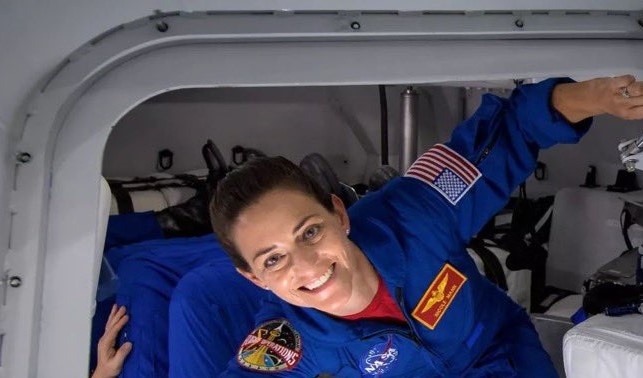
Every year, October 4-10 is observed as World Space Week, the largest space event on Earth. “Space and Sustainability” is the United Nations-declared theme for 2022.
On Wednesday, Oct. 5, NASA and SpaceX once again geared up to launch a crew on an American rocket and spacecraft to the International Space Station to perform science, technology demonstrations, and maintenance activities aboard the microgravity laboratory.
A SpaceX Falcon 9 rocket carrying the company’s Dragon spacecraft launched on NASA’s SpaceX Crew-5 mission to the International Space Station at NASA’s Kennedy Space Center in Florida.
On board were the crew members assigned to NASA’s SpaceX Crew-5 mission including NASA astronaut Nicole Mann, the first Native American woman to go to space and the first woman to command a NASA commercial spacecraft.
Other members of the crew include Josh Cassada of NASA, astronaut Koichi Wakata of JAXA (Japan Aerospace Exploration Agency), and cosmonaut Anna Kikina of Roscosmos.
The international crew of four will fly aboard the SpaceX Dragon Endurance spacecraft and will launch on a new Falcon 9 booster to the orbiting laboratory to spend up to six months at the space station before returning to Earth.
“Missions like Crew-5 are proof we are living through a golden era of commercial space exploration. It’s a new era powered by the spirit of partnership, fueled by scientific ingenuity, and inspired by the quest for new discoveries,” said NASA Administrator Bill Nelson in a statement. “During their stay aboard the International Space Station, Crew-5 will conduct more than 200 science experiments and technology demonstrations, including studies on printing human organs in space and better understanding heart disease. While our eyes are focused upward on the heavens, let us never forget these missions will also better life here on Earth.”
Happy #WorldSpaceWeek! It's an exciting day for diversity in space – the 1st Native American woman, @NASA astronaut Nicole Mann @AstroDuke launched on a @SpaceX rocket today & will spend 6 months at the #ISS. #diversity #inclusivity #womeninspace #spaceforabetterworld #Crew5 pic.twitter.com/uTOEjY1PR7
— Christina Korp (@Xtina_Korp) October 5, 2022
During Dragon’s flight, SpaceX will monitor a series of automatic spacecraft maneuvers from its mission control center in Hawthorne, California, and NASA teams will monitor space station operations throughout the flight from the Mission Control Center at the agency’s Johnson Space Center in Houston.
Dragon will dock autonomously to the space-facing port of the station’s Harmony module around 4:57 p.m. Thursday, Oct. 6. NASA Television, the NASA app, and the agency’s website will provide live coverage of docking and hatch opening. NASA also will cover the ceremony to welcome the crew aboard the orbital outpost about 8:15 p.m.
Crew-5 will spend several months aboard the space station conducting new scientific research in areas, such as cardiovascular health, bioprinting, and fluid behavior in microgravity to prepare for human exploration beyond low-Earth orbit and to benefit life on Earth.
This will be Mann’s first spaceflight since becoming an astronaut in 2013. As mission commander, she will be responsible for all phases of flight, from launch to re-entry. She will serve as an Expedition 68 flight engineer aboard the station.
Mann was born in Petaluma, California, and will be the first indigenous woman from NASA in space. She earned a bachelor’s degree in mechanical engineering from the United States Naval Academy and a master’s degree in mechanical engineering with a specialty in fluid mechanics from Stanford University. She is a colonel in the U.S. Marine Corps and served as a test pilot in the F/A-18 Hornet and Super Hornet.
This will also be Cassada’s first flight since his selection as an astronaut in 2013. As a pilot, he will be responsible for spacecraft systems and performance. Aboard the station, he will serve as an Expedition 68 flight engineer.
Cassada grew up in White Bear Lake, Minnesota, and is a physicist and U.S. Navy test pilot. Prior to becoming a naval aviator, Cassada earned a bachelor’s degree in physics at Albion College and a doctorate at the University of Rochester, conducting experimental high-energy physics research at Fermi National Accelerator Laboratory.
Wakata will be making his fifth trip to space and as a mission specialist, he will work closely with the commander and pilot to monitor the spacecraft during the dynamic launch and re-entry phases of flight. Once aboard the station, he will be a flight engineer for Expedition 68. With Crew-5’s launch, Dragon will be the third different type of spacecraft that Wakata has flown to space.
Kikina will be making her first trip to space and will serve as a mission specialist, working to monitor the spacecraft during the dynamic launch and re-entry phases of flight. She will be a flight engineer for Expedition 68.
Crew-5 will conduct new and exciting scientific research in areas including cardiac to prepare for human exploration beyond low-Earth orbit and benefit life on Earth.
Experiments will include studies on printing human organs in space, understanding fuel systems operating on the Moon, and better understanding heart disease. These are just some of the more than 200 science experiments and technology demonstrations that will take place during their mission.
The U.S. Army Corps of Engineers has been tasked with…
Brown and Caldwell, a leading environmental engineering and construction firm,…
Humboldt State University, one of four campuses within the California…